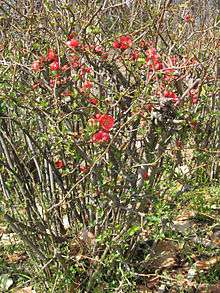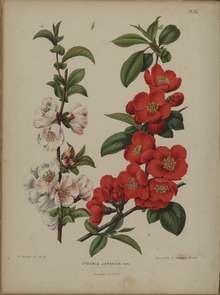Chaenomeles speciosa
| Chaenomeles speciosa | |
|---|---|
 | |
| Flowers of C. speciosa | |
| Scientific classification | |
| Kingdom: | Plantae |
| Clade: | Angiosperms |
| Clade: | Eudicots |
| Clade: | Rosids |
| Order: | Rosales |
| Family: | Rosaceae |
| Genus: | Chaenomeles |
| Species: | C. speciosa |
| Binomial name | |
| Chaenomeles speciosa | |
| Synonyms[1] | |
Chaenomeles speciosa (commonly known as flowering quince, Chinese quince, or Japanese quince;[2] in the context of in traditional Chinese medicine known as zhou pi mugua[3][4]) is a thorny deciduous or semi-evergreen shrub native to eastern Asia. It is taller than another commonly cultivated species, C. japonica, usually growing to about 2 m (6 ft 7 in).[2] The flowers are usually red, but may be white or pink. The fruit is a fragrant but hard pome that resembles a quince.[2]
Cultivation

This plant is widely cultivated in temperate regions for its twining habit and its showy flowers which appear early in the season, occasionally even in midwinter. It is frequently used as an informal low hedge. Numerous cultivars with flowers in shades of white, pink and red have been selected. The following cultivars and hybrids have gained the Royal Horticultural Society's Award of Garden Merit:[5]
Research
A constituent of its extract was found in vitro to be an effective and selective dopamine reuptake inhibitor.[12]
See also
- Pseudocydonia (C. sinensis), also called mugua and Chinese quince; also extensively used in traditional Chinese medicine
- Papaya, a tropical fruit that shares the name mugua
- Scutellaria baicalensis, Huáng qín (Chinese: 黄芩) another traditional Chinese herb that also contains a dopamine reuptake inhibitor
References
- ↑ "The Plant List: A Working List of All Plant Species".
- 1 2 3 Bailey, L.H.; Bailey, E.Z.; the staff of the Liberty Hyde Bailey Hortorium. 1976. Hortus third: A concise dictionary of plants cultivated in the United States and Canada. Macmillan, New York.
- ↑ "Chaenomeles speciosa". Germplasm Resources Information Network (GRIN). Agricultural Research Service (ARS), United States Department of Agriculture (USDA). Retrieved 2 March 2014.
- ↑ Subhuti Dharmananda 2005. "Chaenomeles: A relaxing and strengthening fruit" in Institute for Traditional Medicine database
- ↑ "AGM Plants - Ornamental" (PDF). Royal Horticultural Society. July 2017. p. 16. Retrieved 24 January 2018.
- ↑ "Chaenomeles speciosa 'Geisha Girl' (d) | Japanese quince 'Geisha Girl'/RHS Gardening". RHS - Inspiring everyone to grow / RHS Gardening. UK: The Royal Horticultural Society. 2018. Retrieved 28 May 2018.
- ↑ "Chaenomeles speciosa 'Moerloosei' (d) | Japanese quince 'Moerloosei'/RHS Gardening". RHS - Inspiring everyone to grow / RHS Gardening. UK: The Royal Horticultural Society. 2018. Retrieved 28 May 2018.
- ↑ "Chaenomeles speciosa 'Crimson and Gold' (d) | Japanese quince 'Crimson and Gold'/RHS Gardening". RHS - Inspiring everyone to grow / RHS Gardening. UK: The Royal Horticultural Society. 2018. Retrieved 28 May 2018.
- ↑ "Chaenomeles speciosa 'Knap Hill Scarlet' (d) | Japanese quince 'Knap Hill Scarlet'/RHS Gardening". RHS - Inspiring everyone to grow / RHS Gardening. UK: The Royal Horticultural Society. 2018. Retrieved 28 May 2018.
- ↑ "Chaenomeles speciosa 'Nicoline' (d) | Japanese quince 'Nicoline'/RHS Gardening". RHS - Inspiring everyone to grow / RHS Gardening. UK: The Royal Horticultural Society. 2018. Retrieved 28 May 2018.
- ↑ "Chaenomeles speciosa 'Pink Lady' (d) | Japanese quince 'Pink Lady'/RHS Gardening". RHS - Inspiring everyone to grow / RHS Gardening. UK: The Royal Horticultural Society. 2018. Retrieved 28 May 2018.
- ↑ Zhao G, Jiang ZH, Zheng XW, Zang SY, Guo LH (2008). "Dopamine transporter inhibitory and antiparkinsonian effect of common flowering quince extract". Pharmacol Biochem Behav. 90 (3): 363–71. doi:10.1016/j.pbb.2008.03.014. PMID 18485464.
External links
| Wikimedia Commons has media related to Chaenomeles speciosa. |